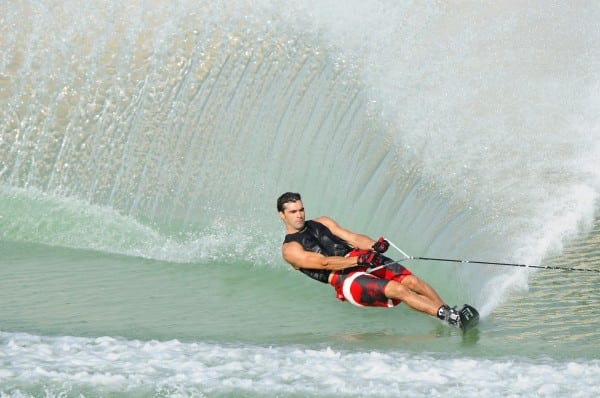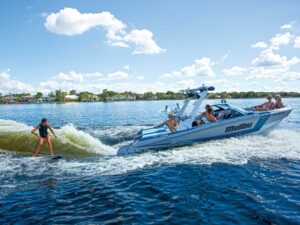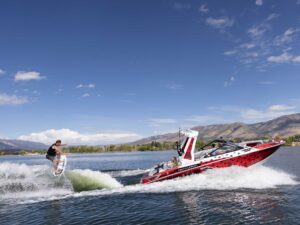
During winter, it’s tempting to forget about skiing for a few months. By doing that, you’ll face an uphill battle to get your endurance and skills back when spring rolls around, and you greatly increase your chances of injury and ruining the next season before it even starts. To keep your batteries charged up this winter, we asked two of skiing’s fittest competitors – Boris Laval and Hanna Edeback – to detail a few of their favorite water ski offseason workouts.
Cycling
The exercise: During the offseason, I do at least 40 minutes of cardio training three times per week. Some people prefer running, but I like biking because it’s easier on your joints – and water skiers typically don’t have the best joints. The downside is that you have to bike twice as much to get the same value from the workout. At first, you don’t have to get your heart rate too high — around 120-130 beats per minute is fine. In fact, it’s better to keep your heart rate low for a longer time. Then, as the tournament seasons approaches, I go for shorter rides, but with more intensity and a higher heart rate.
The benefits: The most important thing is that cardio puts my body back into a neutral position. Skiing is a real anaerobic sport, so I balance that by doing aerobic workouts. And by spring, these workouts leave me feeling lighter with more endurance. Having a strong cardio routine helps me stay at a higher performance level for a longer time. – Boris Laval
Psoas stretch
The exercise: One of my favorite ways to keep my core muscles stretched out is the psoas stretch. I use this stretch before every other exercise I do, usually about twice a day. To stretch your right psoas, stand with your left leg on the floor and right knee on a bench. Put your hands together over your head, move your right hip forward and turn slightly to the left. Hold it 20 to 25 seconds. Reverse and do the other side. The move feels like you’re trying to make the side of your body on the bench as long as possible. You should feel the stretch deep in your core, and it should be pretty intense.
The benefits: Water skiing is an odd sport because we pull with our upper bodies and resist with our lower bodies. The connection between the two is the core, particularly the hip flexors. So in the offseason, I make sure to keep this part of my body stretched out. Stretching the psoas makes you more flexible, and it makes your lower back stronger. I also do it when the season starts as part of my warm-up routine, and that really cuts down on back issues. – Boris Laval
Lunges with weights
The exercise: During winter, a lot of people focus on making their upper bodies strong, but my focus is more on strengthening my legs and core. I get the best leg workouts when I do lunges while holding weights. With a neutral spine, I walk in a straight line holding weights and bend my knees at 90-degree angles during each step. I stay really focused on my balance and keeping my ankles, knees and hips stable. I typically do four sets of 10 lunges (five for each leg). Starting out, I use lighter weights, around 10 pounds, and I slowly progress to heavier weights with fewer reps.
The benefits: This exercise makes my legs feel stronger when I start skiing again. In the spring, my legs used to get exhausted during the first ski sets. My legs wouldn’t be strong enough to resist the force in the wakes and would collapse. But last year, I started incorporating lunges into my off-season workouts, and when the season started up, I didn’t have those issues. – Hanna Edeback
Lunges with medicine ball
The exercise: I like core exercises with movement because it’s similar to what happens on the water. In my favorite core exercise, I hold a medicine ball with both hands and do three different lunges, raising the ball over my head with each step. First, I do lunges to the side, stepping out wide with the medicine ball raised over my head on the step and lowering it when I come back to center. Next, I do a similar movement, except as I make my step to the side, I turn my entire body and step past the point I stepped in the last movement. It’s almost like doing a quarter turn, except the non-stepping foot remains in the original position. Finally, I do a basic straightforward lunge, with both knees at 90-degree angles. For each type of lunge, I do a total of eight lunges, alternating legs each time. I do this routine twice.
The benefits: This exercise gives you a stable core while you’re moving, and that’s important when you’re skiing. It allows me to work on my position and keep my shoulders level right at the start of the season because I am strong enough to actually do it. – Hanna Edeback









